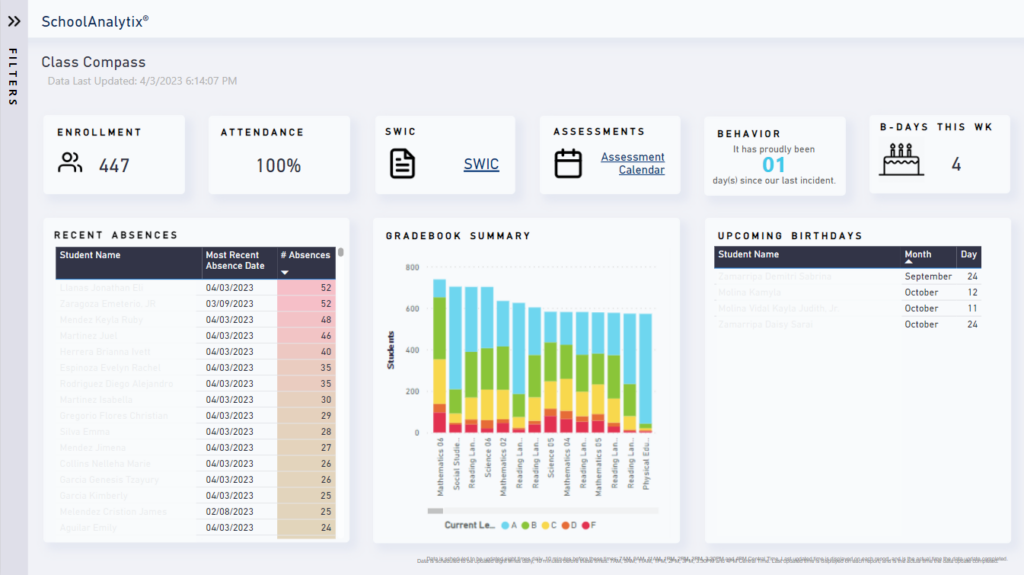In the dynamic landscape of education, the ability to make informed decisions is paramount to the success of schools, educators, and students alike. As schools strive to meet the diverse needs of their students and improve educational outcomes, the use of data-driven decision-making has become increasingly prevalent. School Class Compass Dashboards serve as powerful tools that enable educators and administrators to gain valuable insights into various aspects of student performance, engagement, and wellbeing. In this article, we will explore how School Class Compass Dashboards facilitate the transformation of insights into actionable strategies that drive positive change in education.
Understanding School Class Compass Dashboards
School Class Compass Dashboards are comprehensive data visualization platforms that provide educators and administrators with real-time access to a wide range of academic and non-academic data. These dashboards aggregate data from various sources, including student information systems, learning management systems, assessment tools, and surveys, to provide a holistic view of student performance, behavior, attendance, and other relevant metrics. By presenting data in an intuitive and interactive format, School Class Compass Dashboards empower users to analyze trends, identify patterns, and make informed decisions to support student success.
The Role of Insights in Education
Insights derived from School Class Compass Dashboards offer valuable information that informs decision-making at multiple levels within the education system:
Educator-Level Insights: Educators can use insights from School Class Compass Dashboards to personalize instruction, identify struggling students, and implement targeted interventions. By analyzing student performance data, educators can adjust their teaching strategies to meet the diverse needs of their students and maximize learning outcomes.
School-Level Insights: School administrators can leverage insights from School Class Compass Dashboards to assess overall school performance, track progress towards goals, and allocate resources effectively. By analyzing attendance data, behavior incidents, and academic achievement, administrators can identify areas for improvement and develop strategic plans to address them.
District-Level Insights: District administrators can use insights from School Class Compass Dashboards to evaluate the effectiveness of district-wide initiatives, allocate funding, and ensure equitable access to resources across schools. By analyzing data on student demographics, achievement gaps, and graduation rates, district administrators can identify disparities and implement policies to promote educational equity.
Policy-Level Insights: Policymakers can utilize insights from School Class Compass Dashboards to inform education policy decisions, allocate funding, and evaluate the impact of legislative initiatives. By analyzing data on student outcomes, school performance, and resource allocation, policymakers can develop evidence-based policies that address the needs of students and improve overall education quality.
Driving Decision-Making with School Class Compass Dashboards
School Class Compass Dashboards empower educators, administrators, and policymakers to translate insights into actionable strategies that drive positive change in education:
Identifying Trends and Patterns: School Class Compass Dashboards allow users to identify trends and patterns in student data, such as academic performance, attendance, and behavior. By visualizing data through charts, graphs, and heatmaps, users can quickly identify areas of strength and areas for improvement.
Targeting Interventions: Armed with insights from School Class Compass Dashboards, educators can implement targeted interventions to support struggling students. Whether it’s providing additional academic support, offering social-emotional learning resources, or connecting students with community services, interventions can be tailored to address specific student needs.
Monitoring Progress: School Class Compass Dashboards enable users to monitor student progress in real-time and track the effectiveness of interventions over time. By setting benchmarks and monitoring progress towards goals, educators and administrators can adjust strategies as needed to ensure continuous improvement.
Promoting Accountability: By making data transparent and accessible to stakeholders, School Class Compass Dashboards promote accountability at all levels of the education system. Administrators, educators, students, and parents can all access relevant data and hold themselves and others accountable for student success.
Informing Policy Decisions: Insights from School Class Compass Dashboards provide policymakers with valuable information to inform education policy decisions. By analyzing data on student outcomes, resource allocation, and program effectiveness, policymakers can develop evidence-based policies that address the root causes of educational inequities and improve overall education quality.
Conclusion
School Class Compass Dashboards play a critical role in driving data-driven decision-making and promoting positive change in education. By providing users with valuable insights into student performance, behavior, and engagement, these dashboards empower educators, administrators, and policymakers to implement targeted interventions, monitor progress, and promote accountability. As schools continue to prioritize data-driven decision-making, School Class Compass Dashboards will remain indispensable tools for transforming insights into action and ultimately improving educational outcomes for all students.

